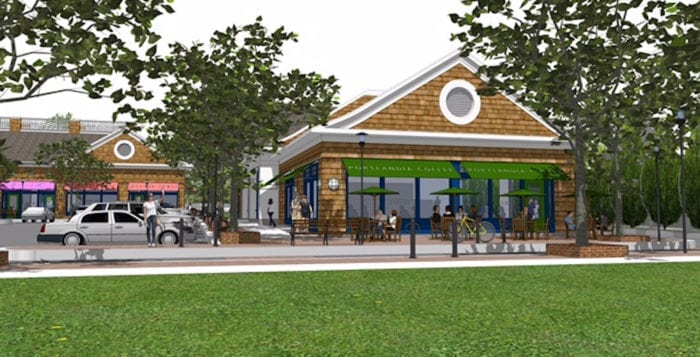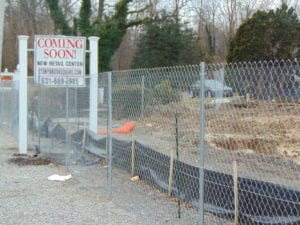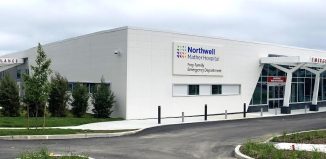Developer decides not to proceed with low-nitrogen septic systems for Stony Brook Square shopping center

By Rita J. Egan
After three years of planning and changes, things are gearing up for the Stony Brook Square shopping center, which will be located near the Long Island Rail Road Station in Stony Brook on Route 25A. However, local environmentalists and legislators are disappointed the developer will not be installing low-nitrogen septic systems.
While the developer, Parviz Farahzad, a former scientist with Brookhaven National Laboratory, was encouraged by Brookhaven Town and the Suffolk County Department of Health Services to install a low-nitrogen septic system, and said he originally hoped to, he has now opted to use a traditional waste system.
“It’s in the area that if you flush the toilet there, under two years that water ends up in the harbor loaded with nitrogen.”
— George Hoffman
In a letter dated Jan. 4, 2017, to Brookhaven Town Supervisor Ed Romaine (R), SCDHS Commissioner James Tomarken said the Stony Brook Square property was proposed to be served by public water and on-site sewage, and advanced wastewater treatment was not required under the current Suffolk County Sanitary Code. However, he wrote that the systems were encouraged by the county for both new development and retrofits to existing development.
“Although nitrogen reduction from advanced wastewater treatment is not required for this project, Suffolk County would be committed to working with the town and the applicant in reviewing the potential use of alternative, advanced wastewater treatment technology,” Tomarken wrote.
George Hoffman, co-founder of the Setauket Harbor Task Force and vice president of the Three Village Civic Association, said he and other environmentalists were disappointed to hear Farahzad was not installing the low-nitrogen systems. Hoffman calls the septic systems the “wave of the future” and said he believes most commercial properties will install them in the next year or so.
“Everybody at some point, when it comes time to redevelopment, they should be putting in low-nitrogen systems,” he said. “It’s crazy to put in the old system that we know really doesn’t work and could cause problems.”
Hoffman said the shopping center site, which is a mile from Stony Brook Harbor, is within the watershed of the waterway.
“It’s in the area that if you flush the toilet there, under two years that water ends up in the harbor loaded with nitrogen,” Hoffman said. “It really is a missed opportunity. He knows our concerns. He can be a real leader here in the community. I think people would think very highly that he was doing the right thing.”

Brookhaven Town Councilwoman Valerie Cartright (D-Port Jefferson Station), who spearheaded community visioning meetings for Route 25A, said the town encourages project applicants to follow environmentally friendly practices when possible.
“In this case, both the town planning board and the 25A Citizens Advisory Commission strongly encouraged the applicant to utilize a low-nitrogen septic system,” Cartright said. “As of earlier last year, it was the town’s understanding that the applicant would be applying for the low-nitrogen system. This recent development is very disappointing and a missed opportunity to benefit our environment.”
According to the SCDHS website, three systems have been approved for commercial properties that process between 1,000 and 15,000 gallons of water per day. According to Tomarken’s letter to Romaine, the calculation for the proposed density flow of the shopping center was 1,800 gpd.
County Legislator Kara Hahn (D-Setauket) said Farahzad met with SCHDS staff members who were eager to assist him, and other Suffolk County developers have used the systems.
“As the county health department works to update county requirements for on-site wastewater treatment, this project could have led the way and shown our community that our drinking and surface waters are a priority to protect,” Hahn said.
Farahzad said he was hesitant to use technology that he feels is fairly new, and he said he feared if it failed it could let off obnoxious odors in an area surrounded by homes.
“If you want true elimination [of nitrogen] — basically what we want for it not to get into the groundwater — you have to have a sewer system.”
— Parviz Farahzad
The developer said such systems only reduce a percentage of nitrogen, and he believes sewers are more appropriate for commercial use. If a sewer district was established in the area, he said he would immediately connect the shopping center to it.
“If you want true elimination [of nitrogen] — basically what we want for it not to get into the groundwater — you have to have a sewer system,” Farahzad said.
Development of the shopping center was approved at the March 6, 2017, Town of Brookhaven Planning Board meeting. Farahzad agreed to add more trees to the final site than originally planned and will require tenants to use signage that consists of wood-base signs with gooseneck lighting, among other concessions after receiving community feedback. He said originally there were plans to add a clock tower; however, residents at a town board meeting objected to permitting a 60-foot height to raise a clock tower in the middle building at the rear of the center.
“It’s going to be something that is good for the community, good for the university, good for The Stony Brook School,” Farahzad said. “These are the people that are going to basically need it.”
In December, the vacant nursery that stood on the land designated for revisioning was demolished, and the parcel is currently fenced off and ready for construction once the weather warms up. Farahzad said it will take a year before the shopping center is completed, and owners of a bank, restaurants, a neighborhood pharmacy and a coffeehouse have already shown interest in leasing.






